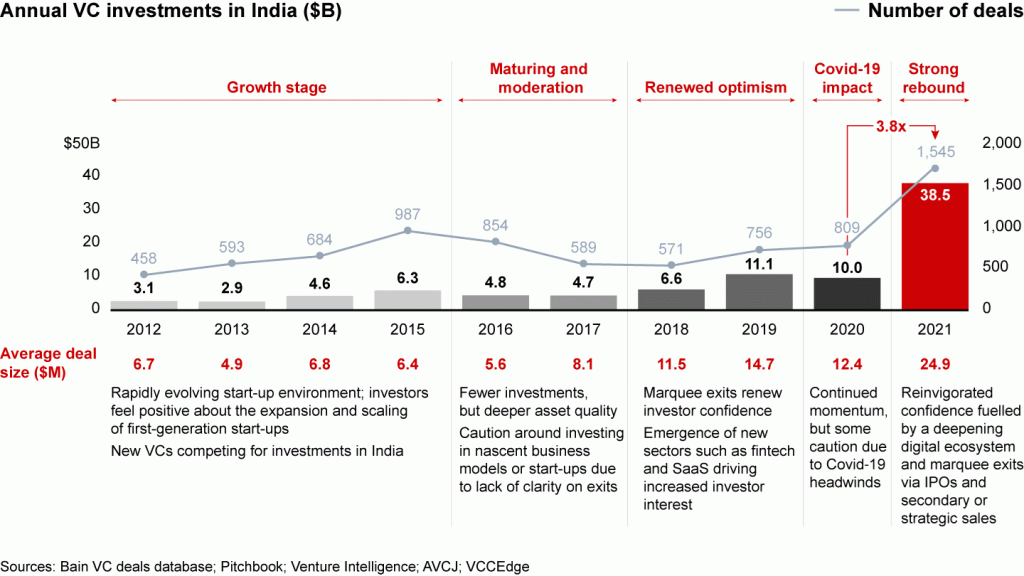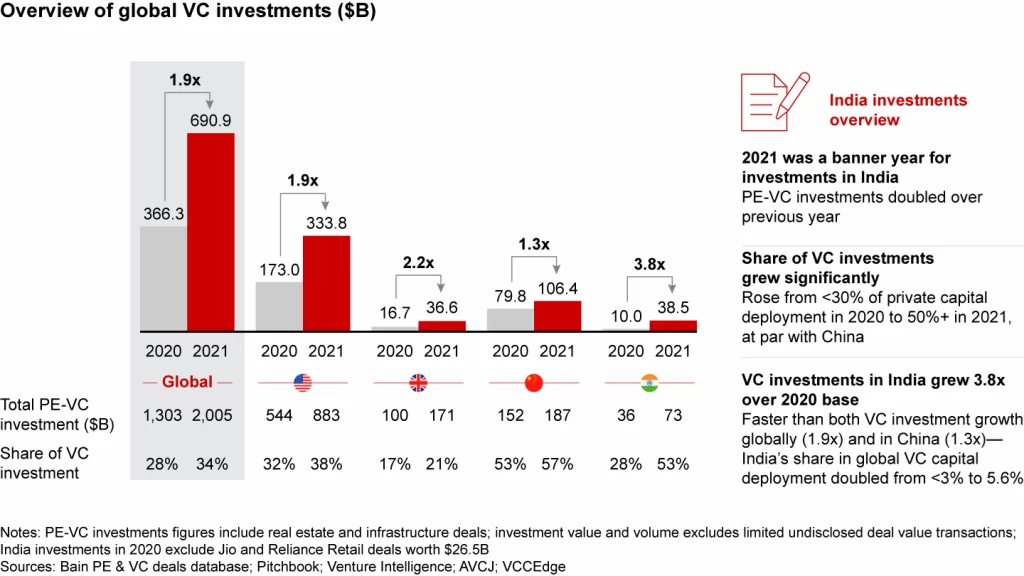CONTENTS
- Micro Venture Capitalist: Small in Size, Big on Impact
- A New Economics for Inclusive Growth
Micro Venture Capitalist: Small in Size, Big on Impact
Context:
There has been a significant surge in micro-venture capital funding in India. Amidst various investors in the startup ecosystem, including angels, incubators, accelerators, family offices, India-focused large funds, and global VC funds, micro-VCs have gained prominence. According to Praxis, their number has increased from around 30 in 2014 to 90 in 2020.
Relevance:
GS3- Indian Economy- Growth and Development
Mains Question:
In the context of the recent surge in micro-venture capital funding in India, examine their role in the development of small businesses in India. (15 Marks, 250 Words)
Significance of Small Businesses in an Economy:
- The significance of small businesses as the lifeblood of any global economy cannot be overstated. In the past fifty years, there has been a notable shift from an industrial economy dominated by large corporations to an innovation-driven entrepreneurial economy where small businesses play a pivotal role.
- According to the World Bank, a staggering 95% of all enterprises in India are small businesses, and despite their size, their contribution to the country’s overall growth is substantial.
- A recent Forbes report highlights that small enterprises contribute 33% to India’s GDP, 40% to its overall industrial production, and 42% to its exports.
Micro- Venture Capitalists:
These emerging entities, identified as micro VC funds, operate with a more modest capital corpus, ranging from $10 million to $100 million, in comparison to their larger counterparts with fund sizes between $50 million and $1 billion.
What Criteria Do Micro VC Funds Consider Before Making Investments?
Micro VC funds take into account the following factors when making investments:
- Sector: Micro VC funds can adopt either a sector-agnostic or sector-specific approach. In India, examples of largely sector-agnostic micro VC funds include 100X VC, gradCapital, and Better Capital, while sector-focused investments are made by Eximius Ventures, Yatra Angel Network, and Suvan Ventures.
- Funding Stage: Micro VC funds typically invest in startups seeking pre-seed to pre-Series A funding. They may also participate in follow-on rounds in Series A and beyond.
- Conditional Funding: Micro VC funds generally provide funding to startups at the post-MVP (minimum viable product) stage. They may issue their initial investment with follow-on contributions or disburse monthly/quarterly funds while actively participating in the growth strategy.
- Number Of Deals: Micro VC funds have the capacity to invest in a range of 50 to 100 deals annually.
Micro- Venture Capitalists Supporting Small Businesses:
- Recognizing the crucial role of small businesses, fostering an entire ecosystem to support their growth and survival is imperative.
- Access to smaller funding options is particularly beneficial for small businesses, as approximately 50% of enterprises fail to extend beyond the initial years.
- Micro-VCs typically engage in pre-seed and seed funding rounds, managing a smaller capital corpus of USD 10-100 million, in contrast to larger VCs with fund sizes ranging from USD 50 million to USD 1 billion.
- Current statistics reveal that micro-VCs have infused USD 346 million into 574 Indian startups through 741 deals from 2014 to 2020.
- These micro-VCs encompass both sector-specific and sector-agnostic funds, with prominent examples being Blume Ventures, gradCapital, Atrium Angels, Better Capital, Capital A, PointOne Capital, Eximius Ventures, Yatra Angel Network, Fluid Ventures, and Pentathion Ventures.
- Distinguishing between angels, family offices, and micro-VCs can be challenging, as the micro-VC market in India often includes wealthy individuals, high-net-worth individuals (HNIs), family offices, and angel investors pooling their funds and expertise to navigate startups efficiently for potential high returns from their high-risk investments.
- Due to their low-ticket size funding, micro-VCs are more likely to expect a 100X return. Moreover, micro-VCs need to decide their investment size and invest in a larger number of companies to fully leverage their investment strategy.


Advantages that micro-VCs offer:
- Firstly, micro-VCs exhibit more flexibility than traditional VCs in choosing the stage of funding and sector.
- Secondly, startups can benefit from the hands-on approach of micro-VCs and leverage their expertise in marketing and strategy.
- Thirdly, micro-VCs are likely to be more approachable, providing entrepreneurs with valuable feedback on business strategies and decisions.
- Fourthly, micro-VCs tend to be patient and willing to wait longer for returns on their investments.
- Lastly, since the funding is smaller, micro-VCs are less likely to exert significant control over the ownership of startups. Therefore, for entrepreneurs seeking to retain control of their companies for a more extended period, securing funding from micro-VCs can be a favorable option.
Conclusion:
While a typical micro-VC may have limited financial and non-financial capital compared to traditional VCs, their growth represents an encouraging development in the Indian startup ecosystem. Micro-VCs play a crucial role by providing options for pre-seed funding, offering vital initial support to small entrepreneurs.
A New Economics for Inclusive Growth
Context:
The inadequacy of jobs and incomes is identified as a critical vulnerability in India’s economy. The evidence is apparent beyond the confines of economists’ datasets. Farmers are advocating for improved prices, while workers in the informal sector and contractual roles are pushing for fair wages and social security. The state of the economy appears unfavorable when 60% of the Indian population, spanning various castes and religions, is categorized as “economically weaker sections” eligible for job reservations.
Relevance:
GS3- Indian Economy- Inclusive Growth
Mains Question:
The obstacle tripping India’s inclusive growth is the mismatch between skills, jobs and incomes of its population. Analyse. (10 Marks, 150 Words).
A Growth-Affecting Discrepancy:
- The impediment hindering India’s growth trajectory is the misalignment among skills, jobs, and incomes.
- Two decades ago, during the era dubbed “India was Shining,” economists believed that India had bypassed manufacturing in the developmental hierarchy. Traditionally, societies transition from agriculture to manufacturing and then to services.
- Unlike China, which elevated its population from poverty by fostering a substantial manufacturing sector and earning the title of the world’s factory, India invested in world-class science and engineering institutions 70 years ago.
- The Indian Institutes of Technology, established during that period, played a crucial role in propelling India’s software industry to global competitiveness and producing CEOs for multinational companies in the United States. India’s space program also achieved noteworthy results at a fraction of the costs incurred by NASA.
- However, despite investing in high-end skills, India’s growth pattern has not generated an adequate number of decent jobs for the masses.
The Overlooked Realities:
- Economic theories, crafted through the analysis of numbers, often overlook realities. Many economists lack an understanding of the “learning” process, which is fundamental to “development.”
- This process involves citizens acquiring new skills to enhance their incomes, and nations gaining capabilities they previously did not possess.
- An agricultural worker is willing to apply intelligence and labor to a new job but cannot afford to take extended breaks from working and earning to learn new skills.
- Consequently, the next job, although different in content, must be sufficiently close to their existing capabilities, allowing for a smooth transition and the continuous enhancement of skills on the job. If the subsequent job is near their current habitation, they also save on living costs.
- Therefore, fostering “adjacencies” in work and location in rural areas proves to be the most effective strategy for ascending the skill-income ladder. Additionally, such adjacencies contribute to the creation of dense networks of economic activity.
- Manufacturing is not confined to large, capital-intensive smartphone factories, and value-adding services extend beyond major software facilities.
- These enterprises engage in processing agricultural produce and transporting and selling it in nearby markets, thereby adding value locally without the need for transportation to more distant, large-scale processing centers.
Way Forward:
- The achievement of trillions of dollars in GDP targets hinges on the imperative shift towards inclusive and sustainable economic growth in the near future. Altering the trajectory of economic growth is essential.
- A higher number of Indians must be gainfully employed, allowing them to earn and learn. By earning more, they contribute to expanding the market for additional producers. Neglecting India’s small-scale and informal manufacturing sector is no longer affordable.
- Despite India’s abundant human resources, large, capital-intensive factories demand more land and financial capital to operate on a significant scale—resources that are relatively scarce in India.
- Investing in education and skills for “high-end” manufacturing and services may not benefit the masses unless they can be effectively employed.
- Fostering economic activity within local networks proves to be more sustainable for growth than participating in long, international supply chains, especially as barriers to such participation increase.
- Given the limited financial capacity of the Indian state, misallocation of funds by reducing taxes and duties and providing incentives to investors, with the expectation that benefits will trickle down to the masses, is unaffordable.
- Importantly, more imports will not enhance the well-being of Indian citizens unless they have increased incomes to spend. Foreign direct investment will not spur growth if it fails to generate employment promptly.
- It is imperative to break free from the economic mold cast in the latter part of the 20th century. Policymakers must reimagine India’s growth path and focus on the fundamentals of inclusive economic growth.
- Manufacturing and value-added services can be successfully executed in rural areas and around farms through small, labor-intensive enterprises with low capital requirements.
Conclusion:
In a global economy that no longer mirrors the growth patterns seen when China became the world’s factory, producers worldwide are actively seeking new markets. India, with its unmet needs, is particularly attractive to them. India’s policies must seize this opportunity, fostering domestic production and growing both jobs and incomes for the masses.





